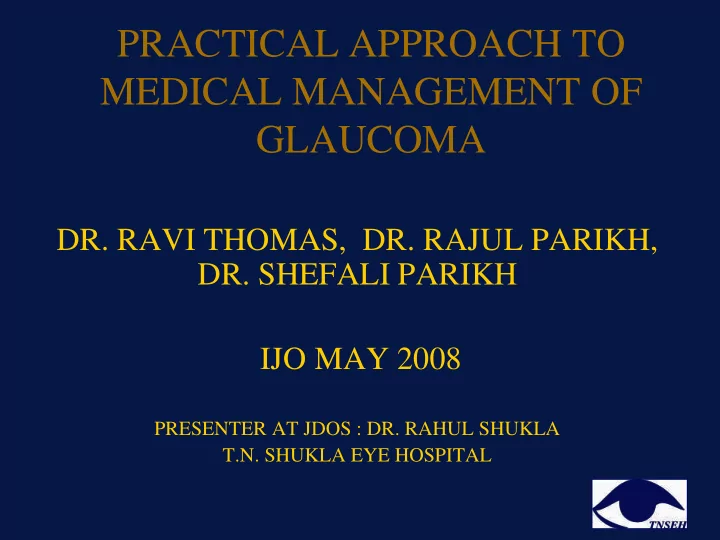

PRACTICAL APPROACH TO MEDICAL MANAGEMENT OF GLAUCOMA DR. RAVI THOMAS, DR. RAJUL PARIKH, DR. SHEFALI PARIKH IJO MAY 2008 PRESENTER AT JDOS : DR. RAHUL SHUKLA T.N. SHUKLA EYE HOSPITAL
TERMINOLOGY • POAG: PRIMARY OPEN ANGLE GLAUCOMA • NTG: NORMAL TENSION GLAUCOMA • OH: OCULAR HYPERTENSION • PRE PERIMETRIC GLAUCOMA • TARGET IOP
POAG : PRIMARY OPEN ANGLE GLAUCOMA • Chronic progressive optic neuropathy. • Characteristic optic disc changes. • Corresponding visual field defects. • IOP only treatable factor. • It’s a diagnosis of exclusion.
NTG: NORMAL TENSION GLAUCOMA • Same as POAG • Except that - CCT corrected IOP is less than 22 mmhg applanation on dirurnal variation.
PREPERIMETRIC GLAUCOMA • Disc changes (cupping) present. • Nerve fiber layer (NFL) changes present. • No defect on white on white perimetry.
BASIC PRINCIPLES 1. Establish a diagnosis. 2. Establish a baseline IOP. 3. Set a target IOP. 4. Initiate therapy to lower IOP to target. 5. Follow up.
ESTABLISH A DIAGNOSIS • CEE Comprehensive Eye Examination • No substitute to CEE • CEE comprises of - Slit lamp biomicroscopy - Goldman applanation tonometry - Gonioscopy, preferably indentation & dynamic - Indirect ophthalmoscopy - Stereoscopic examination of optic disc & NFL
APPLANATION TONOMETRY • Single reading not reliable, poor sensitivity & specificity. • Repeat IOP. • Diurnal variation. • Goldman / Perkins are standard. • Schoitz outdated, very limited role in modern glaucoma management.
GONIOSCOPY • Diagnosis of POAG is by exclusion. • Indentation gonioscopy more useful. • Dynamic procedure should be repeated • Rule out - Narrow angle - Closure - Secondary glaucoma
OPTIC DISC & RNFL ANALYSIS • Best by 60 D or 90 D lens (stereo biomicroscopy). • Red free illumination for Retinal Nerve Fiber Layer. • Stereo photographs of optic disc are gold standard.
IMAGING TECHNIQUES • AIGS (Association of International Glaucoma Societies) does not support the use of • HRT - HEIDELBERG RETINAL TOMOGRAPHY • GDX VCC - SCANNING LASER POLARIMETRY • OCT - OPTICAL COHORENCE TOMOGRAPHY for all patients, but yes in hands of experts for selected cases.
ESTABLISH A BASELINE IOP • IOP - Only known causable and treatable factor. - One time recording of IOP misleading. - Repeat IOP. • DVT (diurnal variation test) ˗ 3 hrly recording of the IOP over 24 hrs. • CCT Central Corneal thickness ˗ To rule out OH & NTG
SET A TARGET IOP • Early Manifest Glaucoma Treatment Study - 25% reduction in IOP reduces progression og glaucoma from 62% to 45% • Collaborative Initial Glaucoma Treatment Study (CIGTS) ˗ Recommends IOP reduction by 35%
CUSTOMIZATION OF TARGET IOP • Structural damage of Optic Disc & RNFL. • Functional damage on white on white perimetry. • Baseline IOP at which damage occurred. • Age • Presence of additional risk factors.
FORMULA FOR TARGET IOP • Rule of thumb - 20% reduction for mild cases. - 30 % for moderate cases. - 40 % for severe cases.
TO LOWER IOP TO TARGET LEVELS Following factors to be kept in mind • Efficacy • Compliance • Safety • Persistence • Affordability • If cost effective & minimum dosage then compliance improves.
20% REDUCTION • Beta blockers are treatment of choice. • Efficacy of these drugs reduce if patient is already on systemic beta blockers.
35% REDUCTION • Prostaglandin analogues • Latanoprost 0.005% requires cold chain except new Latoprost RT. • Bimatoprost 0.03% most effective of all PG analogues but more side effects, hyperemia, trichomegaly, darkening of lids and iris pigmentation. • Travoprost 0.004%
PROSTAGLANDIN ANALOGUES • Don’t use them in inflammatory glaucomas. • If no response then try switching brands because some patients respond. • They are now the most preferred line of management in Non inflammatory glaucomas.
MORE THAN 40% REDUCTION • Combinations are most preferred. • No single drug can reduce the IOP lower than 40%. • Brimonidine tartarate (alpha 2 agonist) • Dorsolamide (carbonic anhydrase inhibitor) • Beta blockers • Prostaglandin analogues • Use in combinations which have minimal dosage and are cost effective.
DOSAGE • Beta blockers - twice daily • Alpha 2 agonists - three times a day if used as single therapy and twice daily if in combination. • Dorsolamide – same as alpha 2 agonists. • Prostaglandin analogues – single dose, preferably at night.
SYSTEMIC DRUGS • Mannitol 20% - IV fast 100 ml to 300 ml • Acetazolamide 250 mg. tablet up to 4 times a day.
SIDE EFFECTS TO BE MENTIONED TO PATIENT • Beta blockers - dryness, itching, punctal compression after putting drops to prevent systemic side effects, systemic (bronchiospasm) • PG Analogues - hyperemia, trichomegaly, darkening of lashes, iris, skin of lids. ( all are reversible), irritation, burning sensation and lid oedema.
MOST IMPORTANT • An information leaflet regarding glaucoma and counseling the patient and relatives. • Its your approach that makes the patient go ahead for treatment and regular follow up. • Give time to your glaucoma patient. • Praise the lower IOP value in follow up visits and the effort he/she has put in taking the treatment.
THANK YOU
Recommend
More recommend